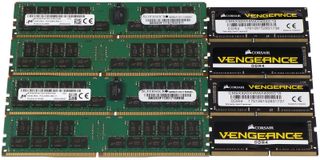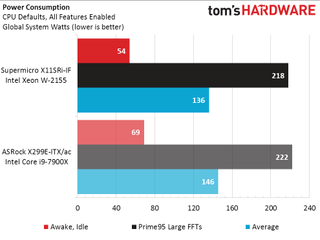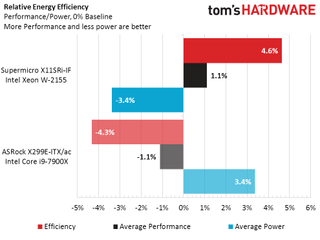Why you can trust Tom's Hardware
Benchmarks
Supermicro wants you to believe that its X11SRi-IF is unique in its support for a 140W LGA 2066 Xeon, but ASRock did the same thing for the Core i9 version of this CPU two years ago in its X299E-ITX/ac. Since the Xeon W-2155 and Core i9-7900X are supposed to be identical from the perspective of our benchmarks, this leaves the two boards to compete based on other parameters, which primarily relate to the type of memory used.

The X11SRi-IF requires ECC-registered DIMMs, and the ones we’re using have twice as many ranks and twice as many banks per rank as a standard 8GB UDIMM. While both features can dramatically improve memory performance, the same ECC technology that improves data accuracy can also put a damper on performance. Though we didn’t have a set of four non-ECC modules at the same capacity, we used a set of SODIMMs that defaulted to the same DDR4-2666 rating on the X299E-ITX/ac to keep things as fair as possible.
Sandra, 3DMark and PC Mark
We lead with memory performance just to see how badly ECC would impact its performance, or how much the extra ranks and banks would help. It’s obvious here that the performance advantage of doubling the ranks per channel and doubling the banks per rank far outweighs the performance deficit of verifying parity bits via ECC.








Looking at a few scores from 3DMark and PCMark, the Supermicro X11SRi-IF also appears to hold up its processor’s higher Turbo Boost ratios a little longer than the X299E-ITX/ac. Remember, both the Xeon and Core i9 have the same Turbo Boost rating.
3D Games


You probably won’t be using a Xeon for gaming, but if you do, you’ll be happy to see that the X11SRi-IF outperforms the X299E-ITX/ac in both Ashes and F1 2017. The later benchmark is known to be somewhat dependent on memory performance, particularly at its lower quality settings.
Mixed Workloads




The X11SRi-IF squeaks out a win in 7-Zip, but the X299E-ITX/ac solidly thumps it in Cinebench. The two appear evenly matched in our classic timed tests.
Power, Heat and Efficiency
The X22SRi-IF pulls much less power at idle than the X299E-ITX/ac, but the difference mostly goes away at full load. We had to test both with Prime95’s less-stressful “Large FFTs” because neither could hold both processors up to their rated Turbo Boost ratios when running the stressful Small FFTs test.

We should also note that our particular power supply can idle down to around 1W with the X299E-ITX/ac turned off, but the power supply can’t be turned off completely when connected to the X11SRi-IF and instead pulls up to 15W in standby mode. With different power supplies treating such a low-load condition differently, your results will vary.

The X11SRi-IF’s CPU ran a little cooler, but its voltage regulator a little warmer, using our Fractal Design Celsius S24 closed-loop cooler with fans atfull speed to provide the voltage regulator’s required airflow.

The X11SRi-IF performed a little more than 2% better on average than the X299E-ITX/ac, and based on our previous memory test we’re betting that most of that gain should be credited to the manufacturer’s choice of memory. We simply didn’t have a set of 8GB single-rank ECC DIMMs from which to produce a more closely-matched configuration.
Final Thoughts
Our performance-per-dollar chart is complicated not just by the fact that the X299E-ITX/ac has far more features or that the X11SRi-IF supports server processors and DRAM, but that Supermicro doesn’t yet have a US retailer for the board. Priced around £320 in UK tax included (and $330 US before tax), Supermicro is currently offering any distributor that wants these a low price of $256 in quantities of 2000. Thus, we used $300 as a best-estimate.

Pricing doesn’t get any easier for the X299E-ITX/ac, because this current model was always intended to be a limited release, and the sellers that still have these have tacked on a 50% surcharge for the privilege. We had to turn back to its original $400 MSRP simply to get back to basics.
The X299E-ITX/ac probably has $100 worth of extra features, and it supports a far cheaper processor model to provide the same number of cores and frequency. Yet for those who want ECC and advanced remote management, the X11SRi-IF’s feature set will appear superior.
In the end, it’s the lack of consumer-friendly I/O that has us considering the X11SRi-IF only as a prosumer number crunching platform, and not a primary PC. Server guys will be happy to hear that, but most end users at this point will probably just go with something AMD for a plethora of cores at a reasonable price.
MORE: Best Motherboards
MORE: How To Choose A Motherboard
MORE: All Motherboard Content

